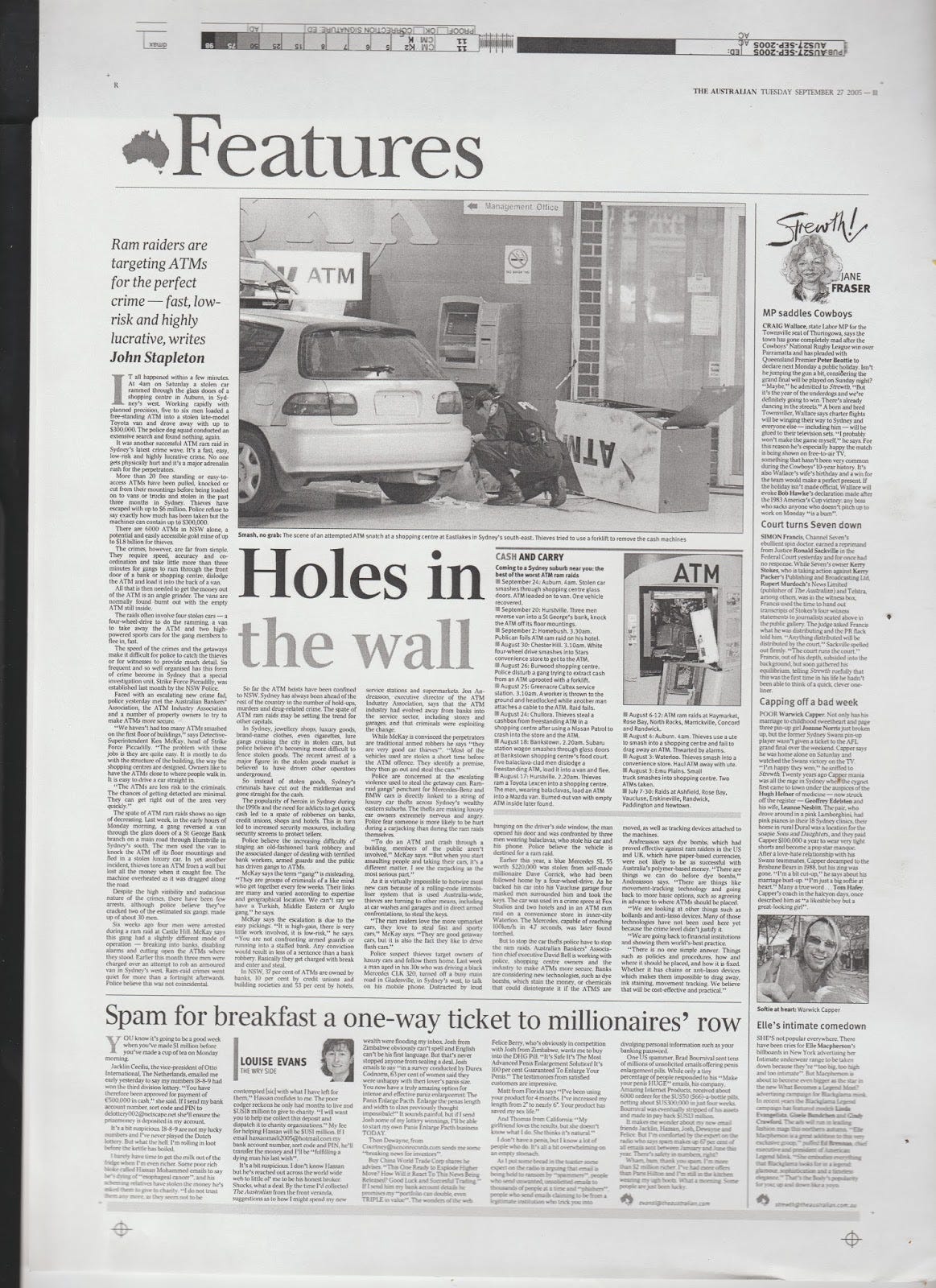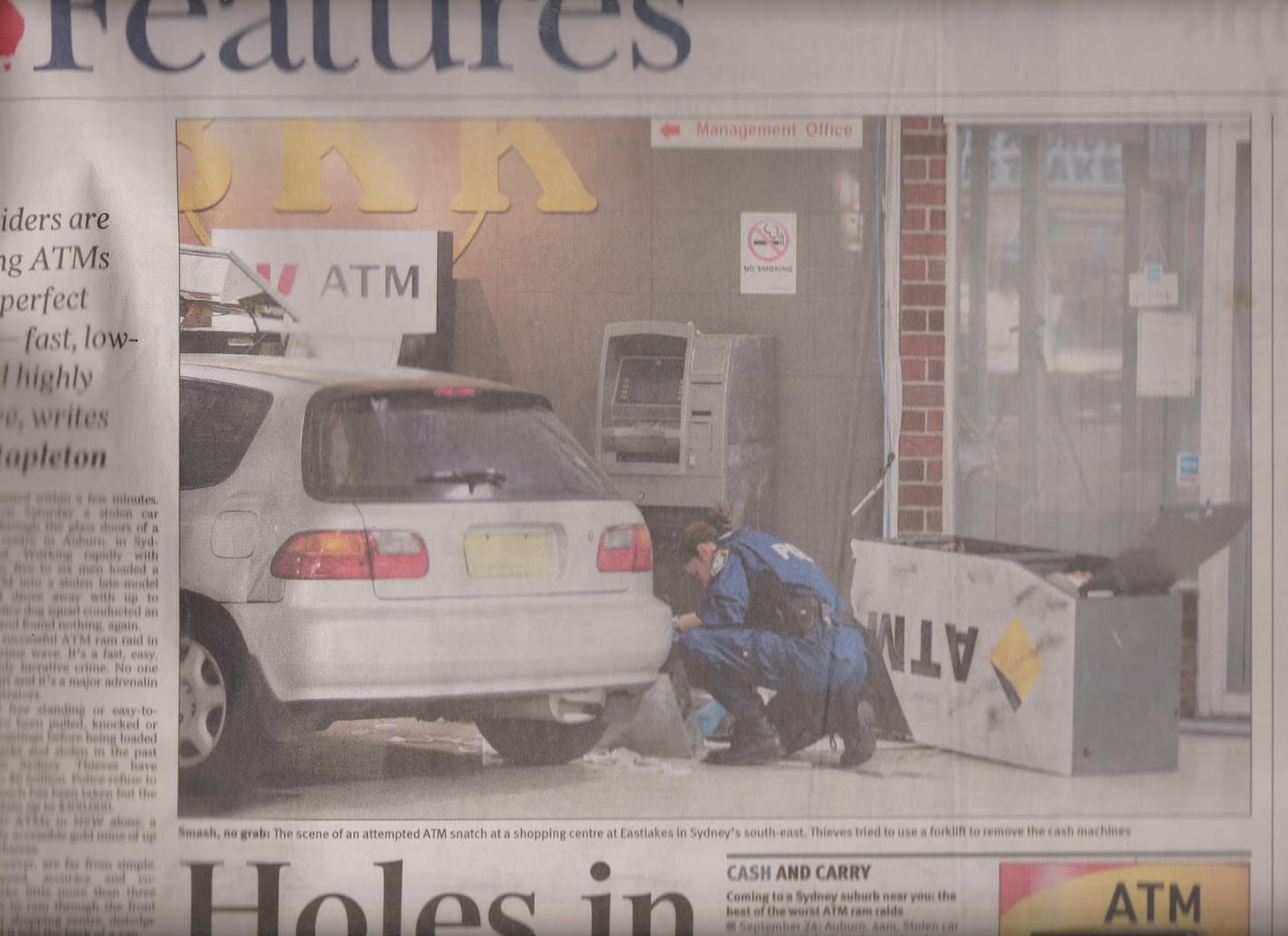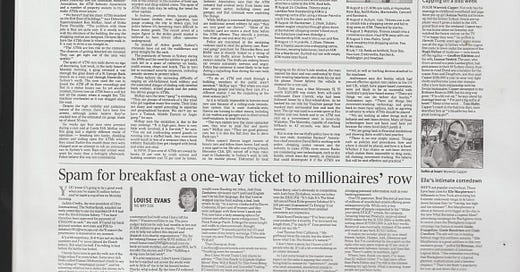
Holes in the wall: [1 All-round Country Edition]
Stapleton, John. The Australian [Canberra, A.C.T] 27 Sep 2005: 11.
Abstract
The spate of ATM ram raids shows no sign of decreasing. Last week, in the early hours of Monday morning, a gang reversed a van through the glass doors of a St George Bank branch on a main road through Hurstville in Sydney's south. The men used the van to knock the ATM off its floor mountings and fled in a stolen luxury car. In yet another incident, thieves tore an ATM from a wall but lost all the money when it caught fire. The machine overheated as it was dragged along the road.
So far the ATM heists have been confined to NSW. Sydney has always been ahead of the rest of the country in the number of hold- ups, murders and drug-related crime. The spate of ATM ram raids may be setting the trend for other capitals.
* August 17: Hurstville. 2.20am. Thieves ram a Toyota Lexcen into a shopping centre. The men, wearing balaclavas, load an ATM into a Mazda van. Burned-out van with empty ATM inside later found.
Full Text
Ram raiders are targeting ATMs for the perfect crime -- fast, low- risk and highly lucrative, writes John Stapleton
IT all happened within a few minutes. At 4am on Saturday a stolen car rammed through the glass doors of a shopping centre in Auburn, in Sydney's west. Working rapidly with planned precision, five to six men loaded a free-standing ATM into a stolen late-model Toyota van and drove away with up to $300,000. Thepolice dog squad conducted an extensive search and found nothing, again.
It was another successful ATM ram raid in Sydney's latest crime wave. It's a fast, easy, low-risk and highly lucrative crime. No one gets physically hurt and it's a major adrenalin rush for the perpetrators.
More than 20 free standing or easy-to-access ATMs have been pulled, knocked or cut from their mountings before being loaded on to vans or trucks and stolen in the past three months in Sydney. Thieves have escaped with up to $6 million. Police refuse to say exactly how much has been taken but the machines can contain up to $300,000.
There are 6000 ATMs in NSW alone, a potential and easily accessible gold mine of up to $1.8 billion for thieves.
The crimes, however, are far from simple. They require speed, accuracy and co-ordination and take little more than three minutes for gangs to ram through thefront door of a bank or shopping centre, dislodge the ATM and load it into the back of a van.
All that is then needed to get the money out of the ATM is an angle grinder. The vans are normally found burnt out with the empty ATM still inside.
The raids often involve four stolen cars -- a four-wheel-drive to do the ramming, a van
to take away the ATM and two high-
powered sports cars for the gang members to flee in, fast.
The speed of the crimes and the getaways make it difficult for police to catch the thieves or for witnesses to provide much detail. So frequent and so well organised has this form of crime become in Sydney that a special investigation unit, Strike Force Piccadilly, was established last month by the NSW Police.
Faced with an escalating new crime fad, police yesterday met the Australian Bankers' Association, the ATM Industry Association and a number of property owners to try to make ATMs more secure.
"We haven't had too many ATMs smashed on the first floor of buildings," says Detective-Superintendent Ken McKay, head of Strike Force Piccadilly. "Theproblem with these jobs is they are quite easy. It is mostly to do with the structure of the building, the way the shopping centres are designed. Owners like to have the ATMs close to where people walk in. It is easy to drive a car straight in.
"The ATMs are less risk to the criminals. The chances of getting detected are minimal. They can get right out of the area very quickly."
The spate of ATM ram raids shows no sign of decreasing. Last week, in the early hours of Monday morning, a gang reversed a van through the glass doors of a St George Bank branch on a main road through Hurstville in Sydney's south. The men used the van to knock the ATM off its floor mountings and fled in a stolen luxury car. In yet another incident, thieves tore an ATM from a wall but lost all the money when it caught fire. The machine overheated as it was dragged along the road.
Despite the high visibility and audacious nature of the crimes, there have been few arrests, although police believe they've cracked two of the estimated six gangs, made up of about 30 men.
Six weeks ago four men were arrested during a ram raid at Castle Hill. McKay says this gang had a slightly different mode of operation -- breaking into banks, disabling alarms and cutting open the ATMs where they stood. Earlier this month three men were charged over an attempt to rob an armoured van in Sydney's west. Ram-raid crimes went quiet for more than a fortnight afterwards. Police believe this was not coincidental.
So far the ATM heists have been confined to NSW. Sydney has always been ahead of the rest of the country in the number of hold- ups, murders and drug-related crime. The spate of ATM ram raids may be setting the trend for other capitals.
In Sydney, jewellery shops, luxury goods, brand-name clothes, even cigarettes, lure gangs cruising the city in stolen cars, but police believe it's becoming more difficult to fence stolen goods. The recent arrest of a major figure in the stolen goods market is believed to have driven other operators underground.
So instead of stolen goods, Sydney's criminals have cut out the middleman and gone straight for the cash.
The popularity of heroin in Sydney during the 1990s and the need for addicts to get quick cash led to a spate of robberies on banks, credit unions, shops and hotels. This in turn led to increased security measures, including security screens to protect tellers.
Police believe the increasing difficulty of staging an old- fashioned bank robbery and the associated danger of dealing with terrified bank workers, armed guards and the public has driven gangs to ATMs.
McKay says the term "gang" is misleading. "They are groups of criminals of a like mind who get together every few weeks. Their links are many and varied according to expertise and geographical location. We can't say we have a Turkish, Middle Eastern or Anglo gang," he says.
McKay says the escalation is due to the easy pickings. "It is high-gain, there is very little work involved, it is low-risk," he says. "You are not confronting armed guards or running into a staffed bank. Any conviction would result in less of a sentence than a bank robbery. Basically they get charged with break and enter and steal.
In NSW, 37 per cent of ATMs are owned by banks, 10 per cent by credit unions and building societies and 53 per cent by hotels, service stations and supermarkets. Jon Andreasson, executive director of the ATM Industry Association, says that the ATM industry had evolved away from banks into the service sector, including stores and garages, and that criminals were exploiting the change.
While McKay is convinced the perpetrators are traditional armed robbers he says "they are very good car thieves". "Most of the vehicles used are stolen a short time before the ATM offence. They identify a premise, they then go out and steal the cars."
Police are concerned at the escalating violence used to steal the getaway cars. Ram-raid gangs' penchant for Mercedes-Benz and BMW cars is directly linked to a string of luxury car thefts across Sydney's wealthy eastern suburbs. The thefts are making luxury car owners extremely nervous and angry. Police fear someone is more likely to be hurt during a carjacking than during the ram raids themselves.
"To do an ATM and crash through a building, members of the public aren't involved," McKay says. "But when you start assaulting people and taking their cars, it's a different matter. I see the carjacking as the most serious part."
As it is virtually impossible to hotwire most new cars because of a rolling-code immobiliser system that is used Australia-wide, thieves are turning to other means, including at car washes and garages and in direct armed confrontations, to steal the keys.
"The ram raiders love the more upmarket cars, they love to steal fast and sporty
cars," McKay says. "They are good getaway cars, but it is also the fact they like to drive flash cars."
Police suspect thieves target owners of luxury cars and follow them home. Last week a man aged in his 30s who was driving a black Mercedes CLK 320, turned off a busy main road in Gladesville, in Sydney's west, to talk on his mobile phone. Distracted by loud banging on the driver's side window, the man opened his door and was confronted by three men wearing balaclavas, who stole his car and his phone. Police believe the vehicle is destined for a ram raid.
Earlier this year, a blue Mercedes SL 55 worth $220,000 was stolen from self-made millionaire Dave Corrick, who had been followed home by a four-wheel-drive. As he backed his car into his Vaucluse garage four masked men surrounded him and took the keys. The car was used in a crime spree at Fox Studios and two hotels and in an ATM ram raid on a convenience store in inner-city Waterloo. The Mercedes, capable of reaching 100km/h in 4.7 seconds, was later found torched.
But to stop the car thefts police have to stop the ram raids. Australian Bankers' Association chief executive David Bell is working with police, shopping centre owners and the industry to make ATMs more secure. Banks are considering new technologies, such as dye bombs, which stain the money, or chemicals that could disintegrate it if the ATMS are moved, as well as tracking devices attached to the machines.
Andreasson says dye bombs, which had proved effective against ram raiders in the US and UK, which have paper-based currencies, were not likely to be as successful with Australia's polymer-based money. "There are things we can do before dye bombs," Andreasson says. "There are things like movement-tracking technology and going back to more basic options, such as agreeing in advance to where ATMs should be placed.
"We are looking at other things such as bollards and anti-lasso devices. Many of those technologies have not been used here yet because the crime level didn't justify it.
"We are going back to financial institutions and showing them world's-best practice.
"There is no one simple answer. Things such as policies and procedures, how and where it should be placed, and how it is fixed. Whether it has chains or anti-lasso devices which makes them impossible to drag away, ink staining, movement tracking. We believe that will be cost-effective and practical."
CASH AND CARRY
Coming to a Sydney suburb near you: the best of the worst ATM ram raids
* September 24: Auburn. 4am. Stolen car smashes through shopping centre glass doors. ATM loaded on to van. One vehicle recovered.
* September 20: Hurstville. Three men reverse van into a St George's bank, knock the ATM off its floor mountings.
* September 2: Homebush. 3.30am. Publican foils ATM ram raid on his hotel.
* August 30: Chester Hill. 3.10am. White four-wheel drive smashes into Stars convenience store to get to the ATM.
* August 26: Burwood shopping centre. Police disturb a gang trying to extract cash from an ATM uprooted with a forklift.
* August 25: Greenacre Caltex service station. 3.10am. A worker is thrown to the ground and headlocked while another man attaches a cable to the ATM. Raid fails.
* August 24: Chullora. Thieves steal a cashbox from freestanding ATM in a shopping centre after using a Nissan Patrol to crash into the store and the ATM.
* August 18: Bankstown. 2.20am. Subaru station wagon smashes through glass doors at Bankstown shopping centre's food court. Five balaclava-clad men dislodge a freestanding ATM, load it into a van and flee.
* August 17: Hurstville. 2.20am. Thieves ram a Toyota Lexcen into a shopping centre. The men, wearing balaclavas, load an ATM into a Mazda van. Burned-out van with empty ATM inside later found.
* August 6-12: ATM ram raids at Haymarket, Rose Bay, North Rocks, Marrickville, Concord and Randwick.
* August 4: Auburn. 4am. Thieves use a ute to smash into a shopping centre and fail to drag away an ATM. Thwarted by alarms.
* August 3: Waterloo. Thieves smash into a convenience store. Haul ATM away with ute.
* August 3: Emu Plains. Small
truck smashes into shopping centre. Two ATMs taken.
* July 7-30: Raids at Ashfield, Rose Bay, Vaucluse, Erskineville, Randwick, Paddington and Newtown.




